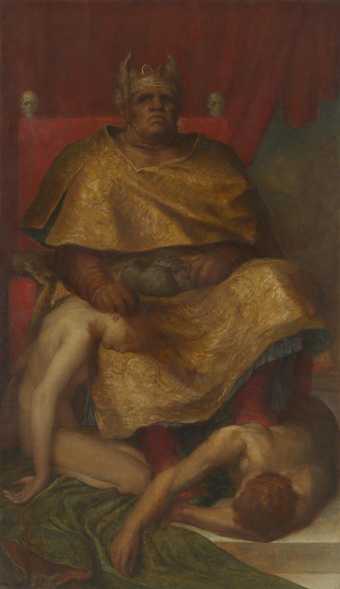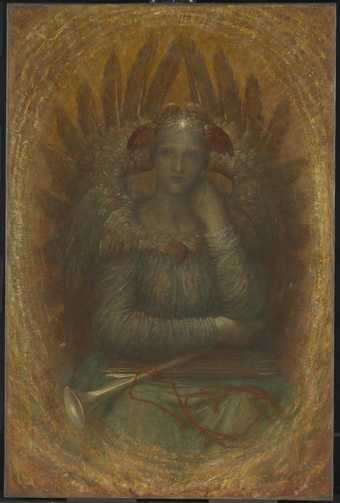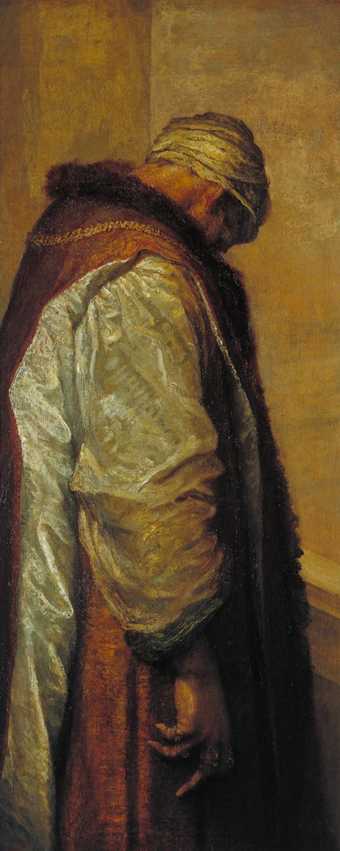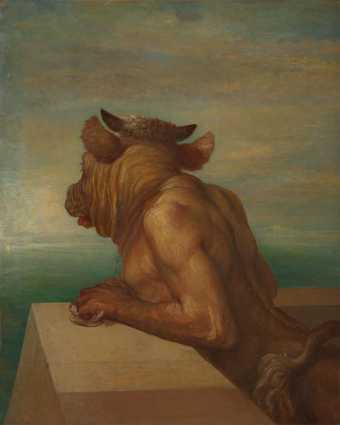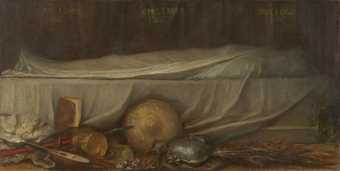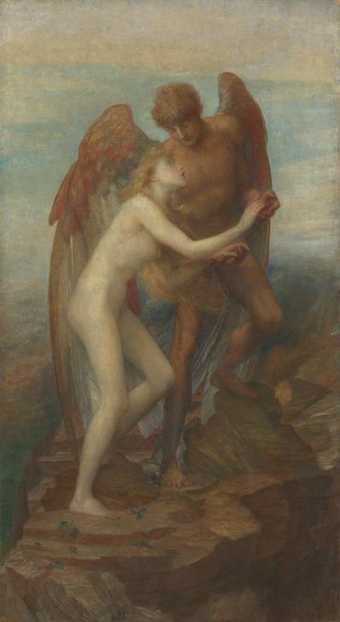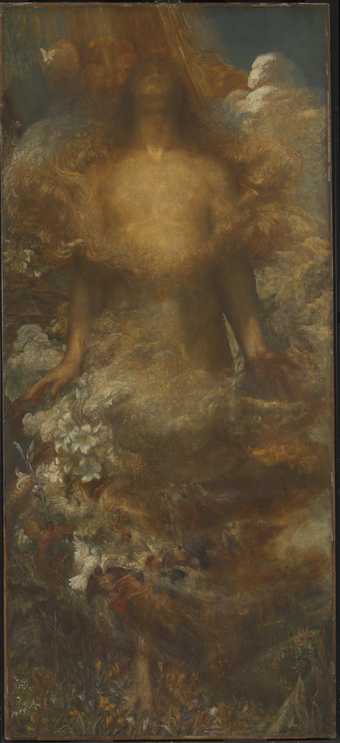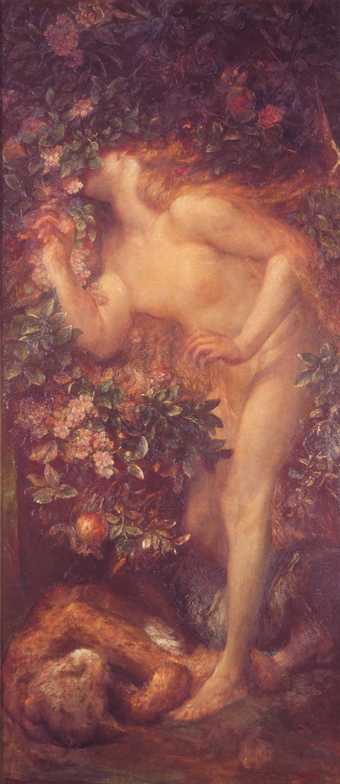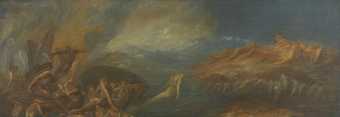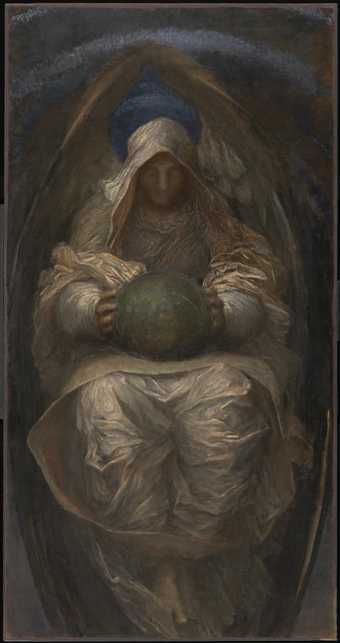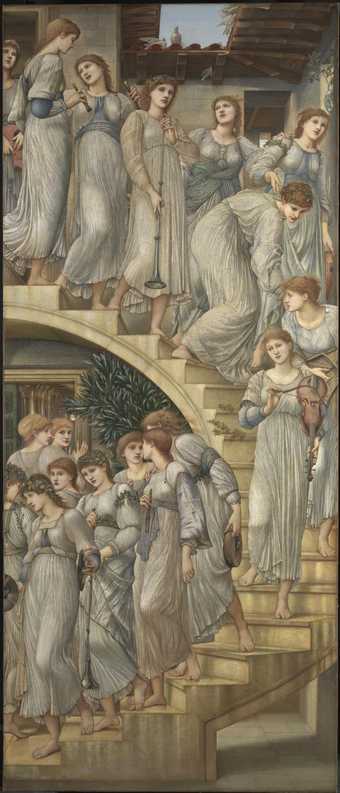
In Tate Britain
- Artist
- George Frederic Watts 1817–1904 and assistants
- Medium
- Oil paint on canvas
- Dimensions
- Support: 1422 × 1118 mm
frame: 1740 × 1425 × 105 mm - Collection
- Tate
- Acquisition
- Presented by George Frederic Watts 1897
- Reference
- N01640
Summary
The picture is one of a series of allegorical subjects which Watts intended for a decorative scheme known as the ‘House of Life’. Traditionally the figure of Hope is identified by an anchor, but Watts was seeking a fresher, more original approach. He painted blind Hope seated on a globe and playing on a lyre which has all its strings broken except one. She bends her head to listen to the faint music, but her efforts appear forlorn; the overall atmosphere is one of sadness and desolation rather than hope. The picture’s sense of melancholy is enhanced by the soft brushwork and the translucent mists that envelop the floating globe.
Watts appears to have drawn on several contemporary sources for the figure of Hope. Her pose is comparable to Rossetti’s siren in A Sea Spell of 1877 (Fogg Art Museum, Harvard University) and also recalls Albert Moore’s sleeping women in Dreamers (1882, Birmingham City Museum and Art Gallery). The bandaged head, denoting blindness, may be linked to the allegorical figure of Fortune in Burne-Jones’s The Wheel of Fortune (c.1871, Tullie House Museum and Art Gallery, Carlisle), which was once owned by Watts.
Watts painted two versions of Hope. The original is in a private collection; this version was painted as a replica and presented to Tate in 1897. Following the studio practice of the time, his assistant, Cecil Schott, probably began this work and Watts carried on, completing it fairly quickly. Mrs Barrington, a frequent visitor to Watts’ studio, reported, ‘Signor has painted a second “Hope”, far more beautiful than the one in the Grosvenor Gallery, and one of these he intends to give to the Nation’ (quoted in Wilton & Upstone, pp.201-2).
Watts believed the second picture to be the better version and exhibited it at the South Kensington Museum and at the Exposition Universelle in Paris in 1889. This version is softer in execution and the girl wears a more enigmatic expression on her face. Watts also omitted the star, the only note of optimism, at the top of the picture.
It has been suggested that the mood of desolation may reflect Watts’s own sadness at the death of his adopted daughter Blanche’s one-year old child. Despite its sense of gloom, the picture was well received and proved extremely popular with the public. The artists F.G. Stephens called Hope a ‘piece of tone harmony’ (Athenaeum, 24 April 1888, p.561), inviting comparisons with the work of Whistler and the Aesthetic movement.
Further reading
Andrew Wilton and Robert Upstone (eds), The Age of Rossetti, Burne-Jones & Watts – Symbolism in Britain 1860-1910, exhibition catalogue, Tate Gallery, London 1997, pp.201-2, no.76, reproduced p.65.
Christopher Wood, Victorian Painting, London 1999, pp.196-204, reproduced p.203, in colour.
Frances Fowle
December 2000
Does this text contain inaccurate information or language that you feel we should improve or change? We would like to hear from you.
Display caption
Watts shows the figure of Hope blindfolded on a globe. She is playing a lyre, of which all the strings are broken except one. Several critics argued that Despair would be a more fitting title. Watts clarified: ‘Hope need not mean expectancy. It suggests here rather the music which can come from the remaining chord.’ The painting was much admired at the 1889 Paris Exposition Universelle, the world fair that celebrated France’s empire. It was widely reproduced in print and often seen in Victorian households. Picasso used the painting as a source for The Old Guitarist (1903–4). More recently, Barack Obama claimed it inspired him to enter politics.
Gallery label, June 2021
Does this text contain inaccurate information or language that you feel we should improve or change? We would like to hear from you.
Explore
- emotions, concepts and ideas(16,416)
-
- emotions and human qualities(5,345)
-
- hope(71)
- music and entertainment(2,331)
-
- music(916)
- fine arts and music(3,982)
-
- instrument, lyre(38)
- bandage(43)
- actions: postures and motions(9,111)
-
- sitting(3,347)
- woman(9,110)
You might like
-
George Frederic Watts Psyche
1880 -
George Frederic Watts Mammon
1884–5 -
George Frederic Watts The Dweller in the Innermost
c.1885–6 -
George Frederic Watts ‘For he had great possessions’
1894 -
George Frederic Watts The Minotaur
1885 -
George Frederic Watts Death Crowning Innocence
1886–7 -
George Frederic Watts Sic Transit
1891–2 -
George Frederic Watts Faith
c.1890–6 -
George Frederic Watts Love and Life
c.1884–5 -
George Frederic Watts ‘She shall be called woman’
c.1875–92 -
George Frederic Watts Eve Tempted
exhibited 1884 -
George Frederic Watts The Messenger
c.1884–5 -
George Frederic Watts and assistants Chaos
c.1875–82 -
George Frederic Watts The All-Pervading
1887–90 -
Sir Edward Coley Burne-Jones, Bt The Golden Stairs
1880


